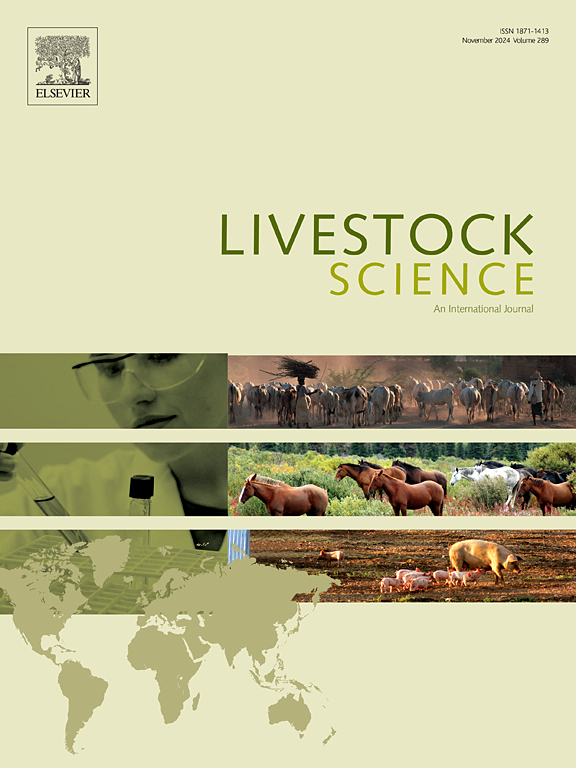杂交猪(约克郡和汉普郡)苍白,柔软和渗出(PSE)样区域的流行和严重程度:对季节,性别,屠宰重量和技术肉类性状的见解
IF 1.9
3区 农林科学
Q2 AGRICULTURE, DAIRY & ANIMAL SCIENCE
引用次数: 0
摘要
猪肉中的苍白,柔软和渗出(PSE)样区域日益受到关注,影响了一些肉类品质属性以及生产经济性。本研究调查了瑞典商品杂交猪(约克郡×汉普郡父系)pse样带的流行程度和严重程度,重点研究了季节、性别、屠宰体重和技术肉质性状等关键因素的影响。在四个季节(秋、冬、春、夏)共采集了192头猪的样本,并对屠宰后的pse样区进行了评估。结果表明,季节对pse样带的流行有显著影响,夏季的流行率明显低于其他季节。性别差异也很显著,与免疫阉割的公猪相比,母猪显示出更高的pse样区发生率。此外,屠宰体重与pse样区患病率显著相关,而受影响肌肉重量的比例显著影响严重程度。在技术肉质性状中,浅度(L*)和黄度(b*)与发病率和严重程度都有很强的相关性,而红度(a*)仅与严重程度有显著的相关性。此外,最终温度(Temp24h)对pse样带的流行有显著影响。这些发现强调了针对特定季节的环境管理和处理措施的重要性,以尽量减少类似pse区的流行和严重程度。整合遗传选择、减轻压力措施和优化屠宰过程的未来战略有可能改善商业猪肉生产系统的肉质结果。本文章由计算机程序翻译,如有差异,请以英文原文为准。
Prevalence and severity of pale, soft, and exudative (PSE)-like zones in crossbred pigs (Yorkshire x Hampshire): Insights into season, gender, slaughter weight and technological meat traits
Pale, soft, and exudative (PSE)-like zones in pork is a growing concern, affecting several meat quality attributes as well as production economics. This study investigates the prevalence and severity of PSE-like zones in Swedish commercial crossbred pigs (Yorkshire dam x Hampshire sire), focusing on the effects of the key factors such as season, gender, slaughter weight and technological meat quality traits. A total of 192 pigs were sampled during four seasons (autumn, winter, spring, summer) and assessed for post-slaughter PSE-like zones. Results revealed that season significantly influenced the prevalence of PSE-like zones, with a notably lower prevalence observed in summer compared to other seasons. Gender differences were also significant, with female pigs showing a higher incidence of PSE-like zones compared to immuno-castrated males. Additionally, slaughter weight was significantly associated with the prevalence of PSE-like zones, while the proportion of affected muscle weight notably influenced severity levels. Among technological meat quality traits, lightness (L*) and yellowness (b*) showed strong associations with both prevalence and severity, while redness (a*) demonstrated a significant association solely with severity. Additionally, ultimate temperature (Temp24h) had a significant effect on prevalence of PSE-like zones. These findings underscore the importance of season-specific environmental management and handling practices to minimize the prevalence and severity of PSE-like zones. Future strategies integrating genetic selection, stress reduction measures, and optimized slaughter processes hold potential for improving meat quality outcomes in commercial pork production systems.
求助全文
通过发布文献求助,成功后即可免费获取论文全文。
去求助
来源期刊

Livestock Science
农林科学-奶制品与动物科学
CiteScore
4.30
自引率
5.60%
发文量
237
审稿时长
3 months
期刊介绍:
Livestock Science promotes the sound development of the livestock sector by publishing original, peer-reviewed research and review articles covering all aspects of this broad field. The journal welcomes submissions on the avant-garde areas of animal genetics, breeding, growth, reproduction, nutrition, physiology, and behaviour in addition to genetic resources, welfare, ethics, health, management and production systems. The high-quality content of this journal reflects the truly international nature of this broad area of research.
 求助内容:
求助内容: 应助结果提醒方式:
应助结果提醒方式:


